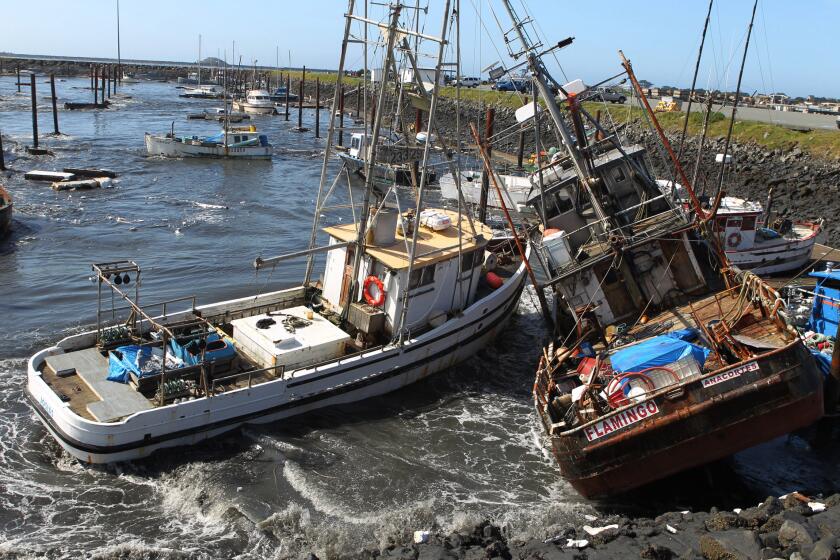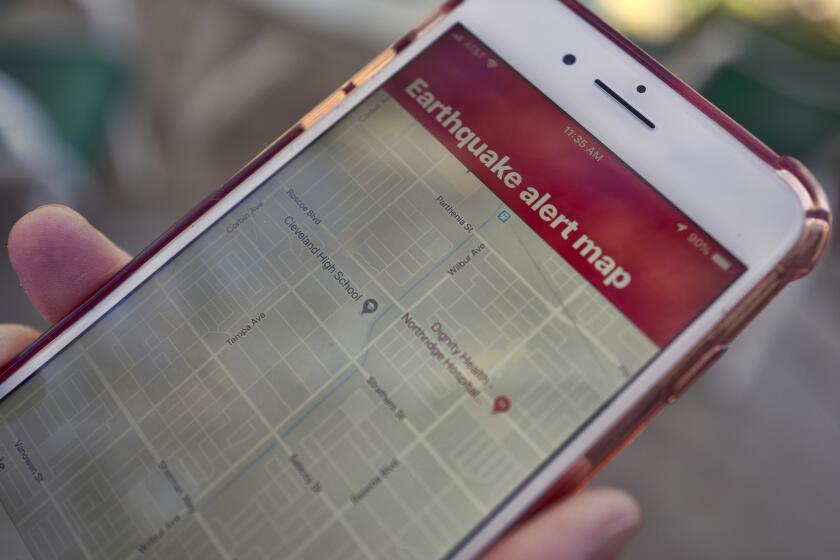Warning Is Issued About Aftershocks : Seismology: Strong temblors that strike after the main quake prompt experts to caution that further jolts may not diminish in intensity.
- Share via
The two big aftershocks, magnitudes 6.5 and 6.0, that struck Humboldt County early Sunday gave rise to concern among earthquake experts that additional aftershocks may not diminish in intensity, as they usually do.
“Based on accumulated scientific information on the area where the earthquakes struck, continuing aftershocks as large as magnitude 5 could occur within the next few weeks and additional aftershocks of magnitude 6 cannot be ruled out,” said the Office of Emergency Services.
As a result, it added: “Extreme caution should be exercised in permitting re-entry to buildings which have already been damaged.”
Waverly Person, chief of the U. S. Geological Survey’s National Earthquake Information Center in Golden, Colo., noted that a few of the most powerful North American earthquake experiences have been a series of jolts rather than a main shock followed by aftershocks of decreasing and considerably lesser intensity.
Person said the most severe earthquake sequence in U. S. history, the New Madrid, Mo., temblors of 1811-12, began with a magnitude 8.6 quake and was followed within two months by magnitude 8.4 and 8.7 shocks. Altogether, 21 quakes were felt as far away as Washington, D.C.
Person also recalled that on Aug. 16 and 17 last year, a magnitude 6.3 earthquake was followed by a 7.1 earthquake, both centered 65 miles offshore from Crescent City, Calif., less than 150 miles from this past weekend’s temblors. In between the August quakes, a 6.0 shaker struck near Shelter Cove, south of Eureka.
Despite such occurrences, the U. S. Geological Survey and the California Office of Emergency Services said Sunday that the probabilities are that the present aftershocks will weaken and slow down.
Pat Jorgenson, a spokeswoman for the Geological Survey’s Menlo Park office, said that as of noon Sunday, “the probabilities for the next seven days are a 15% chance of one or more magnitude 6 earthquakes, and a 65% chance of magnitude 5 or larger quakes.”
In the past in California, aftershocks have sometimes had fatal results. Two people were killed in Bakersfield in 1952 in an aftershock that followed a quake in Tehachapi by more than a month.
Meanwhile, considerable uncertainty remained about which faults or tectonic plates were responsible for the weekend shakers.
In what is known as the Cape Mendocino fracture zone, three plates--large land masses floating on the molten core of the Earth--come together: the Gorda, the Pacific and the North American. The San Andreas Fault, California’s longest and most dangerous, is within 20 miles.
Person said the Geological Survey has concluded that the San Andreas was not involved in the present earthquake sequence. He said that because of the triple junction of tectonic plates and undersea faults that are not well mapped, the earthquakes have “a complex source, not well understood.”
In Menlo Park and Eureka, seismologists studying the earthquakes said some could be independent of one another, located on separate faults in the area.
Most often in earthquake sequences, the strongest aftershocks are about 1.0 in magnitude less than the main shock. But in several recent California experiences, this has not held. Earthquakes in Bishop, Whittier Narrows and Upland are among those that have had aftershocks close in intensity to the main shock.
Northern California Earthquakes
Significant earthquakes since 1980 in Humboldt and Del Norte counties.
Date Magnitude Epicenter Damage March 3, 1980 5.2 Offshore Punta Gorda None Nov. 8, 1980 7.0 Offshore Eureka 6 injured, freeway overpass collapse Nov. 21, 1986 5.2 Petrolia Breakage Jan. 16, 1990 5.3 Petrolia Breakage Jan. 18, 1990 5.1 Trinidad None Aug. 16, 1991 5.1 Offshore Crescent City None Aug. 17, 1991 6.0 Shelter Cove Minor Aug. 17, 1991 7.1 Offshore Crescent City None March 7, 1992 5.2 Offshore Punta Gorda None Apr. 25, 1992 6.9 Near Petrolia 94 injuries, Apr. 26, 1992 6.0,6.5 Offshore Petrolia Structural damage, building fires
Source: U.S. Geological Survey
More to Read
Sign up for Essential California
The most important California stories and recommendations in your inbox every morning.
You may occasionally receive promotional content from the Los Angeles Times.










